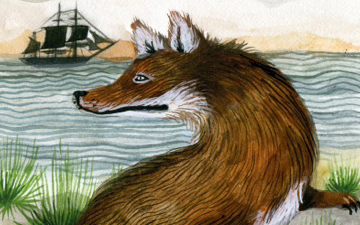The Falkland Islands wolf (Dusicyon australis), also known as the warrah and occasionally as the Falkland Islands dog,Falkland Islands fox, or Antarctic wolf, was the only native land mammal of the Falkland Islands. This endemic canid becameextinct in 1876, the first known canid to have become extinct in historical times. It was the only modern species in the genusDusicyon.
Traditionally it had been supposed that the most closely related genus was Lycalopex, including the culpeo, which has been introduced to the Falkland Islands in modern times. However, in 2009, a cladistic analysis of DNA identified the Falkland Island wolf’s closest living relative as the maned wolf (Chrysocyon brachyurus)—an unusually long-legged, fox-like South American canid, from which it separated about 6.7 million years ago.[3]
The Falkland Islands wolf existed on both West and East Falkland, but Charles Darwin was uncertain if they were differentiated varieties.[4] Its fur had a tawny colour and the tip of the tail was white. Its diet is unknown, but, due to the absence of nativerodents on the Falklands, probably consisted of ground-nesting birds such as geese and penguins, grubs and insects, as well asseashore scavenging.[5] It has sometimes been said that it may have lived in burrows.[6]
(From Wikipedia, June 2016)




